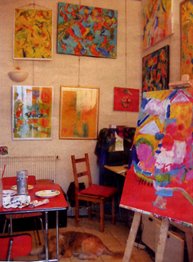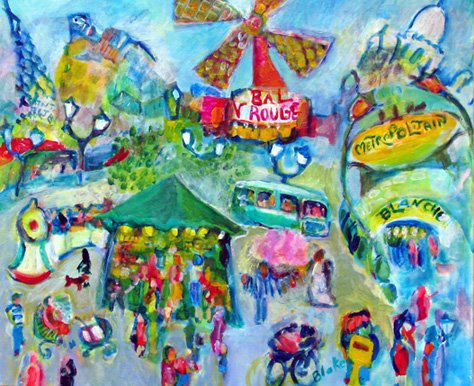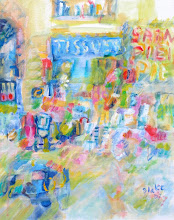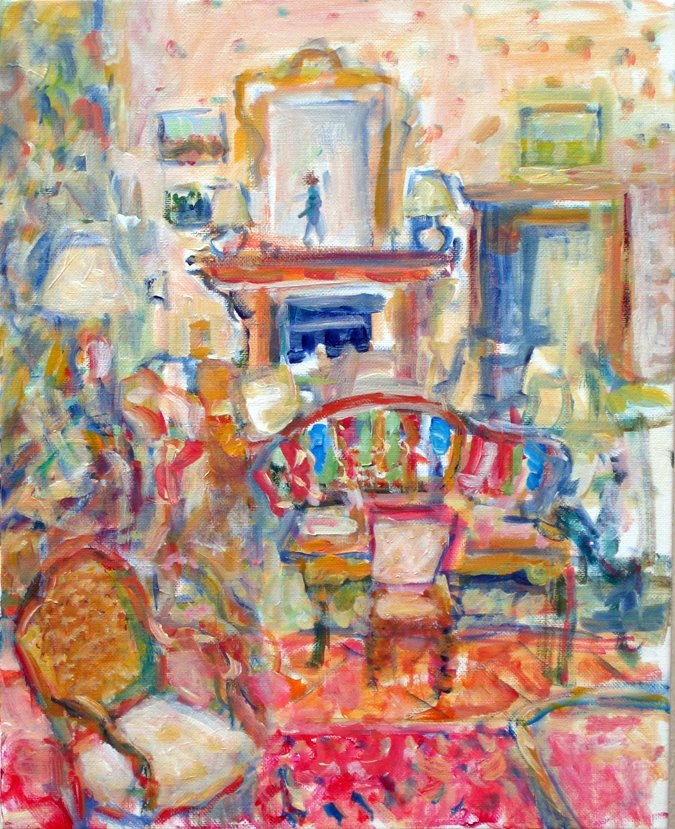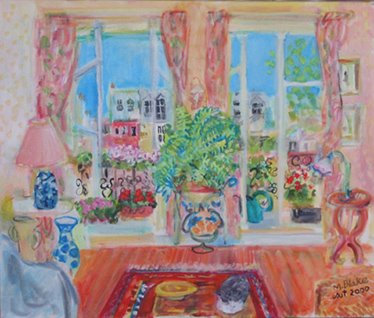
The French have returned to Paris en masse.
 brushes, Windsor Newton water colors, and Arches cold press 300 gram papier.
brushes, Windsor Newton water colors, and Arches cold press 300 gram papier. Creations from 2008-2018, by American artist Mary Blake,a longtime resident of Montmartre where the angels of creativity still abide.

 brushes, Windsor Newton water colors, and Arches cold press 300 gram papier.
brushes, Windsor Newton water colors, and Arches cold press 300 gram papier. 
 I found the bookstore Shakespeare & Co. in November 1972 after renting an apartment on the rue Galande, a narrow ally street just behind the store. Some of my newly found bohemian friends introduced me to George Whitman, the celebrated owner. He seemed indifferent to me until I told him that I had just returned from Martha’s Vineyard. George loved Cape Cod and each time he saw me we talked about clams. That was my pass to get upstairs to what they called the reading room or the library, but most of all it was
I found the bookstore Shakespeare & Co. in November 1972 after renting an apartment on the rue Galande, a narrow ally street just behind the store. Some of my newly found bohemian friends introduced me to George Whitman, the celebrated owner. He seemed indifferent to me until I told him that I had just returned from Martha’s Vineyard. George loved Cape Cod and each time he saw me we talked about clams. That was my pass to get upstairs to what they called the reading room or the library, but most of all it was where we hung out, told stories, drank wine, and dreamed of fame. Being poor was part of it all. It seemed to have a poetic air. By spring, when it was really la fin des hairicots, I was sleeping on a shelf at the store.
where we hung out, told stories, drank wine, and dreamed of fame. Being poor was part of it all. It seemed to have a poetic air. By spring, when it was really la fin des hairicots, I was sleeping on a shelf at the store.George was sitting at his enormous desk drinking his tea staring out the front window.
“That’s nice” he replied.
“I’m looking for a book on yachts. I can’t remember the name, but it weighs about 20 pounds.”
Still monotone, George murmured, “I’ve got a 16 pound book on trains.”
“No! Yachts. Yachts.”
“Sorry.” George replied still staring out the window.
The next day George announced that I was not leaving for New York. He had found a job for me.
I remember the words. "Chateau. Editor for Le Monde and Colette". He sent me down rue de la Bûcherie to visit Colette. Still stunned by this order, I returned and told him that she wasn’t home. He said to knock harder. She was probably sleeping. Which was the case. I rescheduled my plane ticket and was off two days later to what I imagined would be a glorious experience.
I didn’t know at the time that a parc naturist was a nudist colony, that I would be a nanny on my own for three brats, and my place in the château was the attic. I heard the rats, but never saw them. I managed through the episode. It did change the course of my life.
When I did return to New York my apartment had been cleared out and I had lost my lease. A friend put me up for three months. I worked my way back to to Paris to paint for life and that was it.
I met many people through Colette. She was very pretty. Men never stopped falling in love with her. She died young and broke many hearts.
Thirty-five years later I’m still in Paris. And still painting. George has passed the bookstore on to his beautiful daughter Sylvia. She does a good job, and order is her tour de force.
I stopped by the shop last September and saw that they had lost their kitty cat two months ago. Hopeless it seemed.
Nina had just had 3 puppies. I went to the next Monday night reading, and asked her if they would be interested in having a puppy.
Sylvia seemed enthused, but said that she would ask her Dad.
I had not seen him for a few years. I got a call the next morning. "My Dad said that if it’s Mary Blake’s puppy, it ’ll have character. We have to have it.”
When the puppies were six weeks old, George and Sylvia came up to Montmartre for a visit.
When George entered my courtyard, Nina greeted him with her ball. He laughed. He didn’t say much to me, like "nice to see you" or "your paintings look great", but watched the puppies play with my two cats.
I put Coco Bean in his lap. George barked at him. Coco Bean fell to the floor.
"Daddy." Sylvia pleaded. "You scared him."
Colette, the first-born and only female, had caught his fancy. She was already promised, but I placed her in his lap anyway.
I visited George a few days later. "What a wonderful life you must have" he said sitting in his PJ's amidst a sea of clutter. His bedroom walls were covered with photos of the greats of the last century who had visited his shop. Who was not on George's wall? Mic Jaggar perhaps. Jean-Paul Sartre, Laurence Durell, Jacqueline Onassis were as well as Lawrence Ferlingetti and on and on. There was a color photo copy of me and Colette above his night table. "Well George, I've finally made it. I'm on your wall, even if it did take a dog to get me there."
Colette is now at Shakespeare & Co. Almost a year old.

She is not the mascot.
She is George’s dog and he calls her “Kitty”.
I heard that Kitty got into his birthday 94th or 95th cake last winter and demolished it. George thought it was funny.
They are in love.









